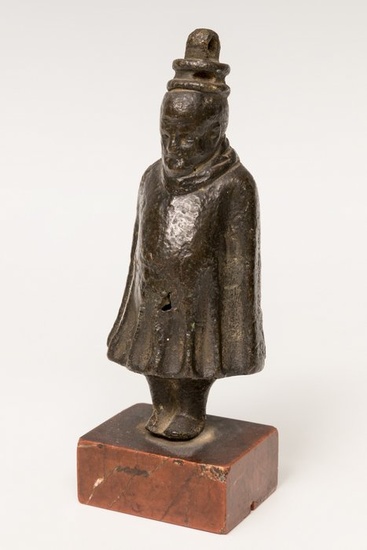Ancient Roman Bronze Cucullatus Deity Figure - 9.8 cm
A very rare roman bronze Genie Cucullatus. Round statuette made by mould, representing a male figure dressed in a tunic with a hood, which marks his large belly, with a broad, domed forehead and a stepped headdress, with a pierced top that allows the piece to be hung and worn as an amulet. With old marble support.
The 'genii cucullati' ('hooded spirits') are religious figures found in the Romano-Celtic regions from Britain to Pannonia. They are depicted as hooded figures, and in the case of Britannia they take the form of a triple deity. The hooded cloak was associated in Roman times with the Gauls and Celts. In fact Telesphorus, the hooded god of health, may have originated in Greco-Galatian syncretism (Anatolia, 3rd century BC) . The religious significance of the hooded genii is not yet clear, as no inscriptions have been found, but there is some evidence to suggest that they may have been spirits associated in some way with fertility. Ronald Hutton notes that in some cases they carry egg-shaped objects, which may symbolise life and rebirth, although Graham Webster has pointed out that these curved forms resemble contemporary Roman phallic stones. In any case, many of these figures carry swords or daggers, which is why some scholars place them in the context of warrior rites. The name Cucu. Ilatus is a derivative of Gaulish cucullos, meaning 'hood'.
Dimensions: 9,80 cm.
Condition. Two small holes on front ( see pictures) . Good condition.
Provenance: Spanish antiquarian. Formerly old belgian private collection.
Notes:
- The piece includes authenticity certificate. The piece is in process of obtaining
Spanish Export License ( Passport for European Union) . This process can take between 2 and 4 weeks.
- If the piece goes outside the European Union a new export license will
be requested by us, This process can take beteen 1 and 2 months.
According to Spanish legislation, items sent outside the European Union
are subject to export taxes and will be added to the invoice, at the
buyer's expense. These export fees are fixed on the final auction price
and the tax rate is not applied directly on the total value of the item
to be exported, but rather the different percentages by sections are
applied to it:
- Up to 6,000 euros: 5%. / From 6. 001 to 60. 000 euros: 10%.
- Shipped with Insurance.
View it on
Estimate
Time, Location
Auction House
A very rare roman bronze Genie Cucullatus. Round statuette made by mould, representing a male figure dressed in a tunic with a hood, which marks his large belly, with a broad, domed forehead and a stepped headdress, with a pierced top that allows the piece to be hung and worn as an amulet. With old marble support.
The 'genii cucullati' ('hooded spirits') are religious figures found in the Romano-Celtic regions from Britain to Pannonia. They are depicted as hooded figures, and in the case of Britannia they take the form of a triple deity. The hooded cloak was associated in Roman times with the Gauls and Celts. In fact Telesphorus, the hooded god of health, may have originated in Greco-Galatian syncretism (Anatolia, 3rd century BC) . The religious significance of the hooded genii is not yet clear, as no inscriptions have been found, but there is some evidence to suggest that they may have been spirits associated in some way with fertility. Ronald Hutton notes that in some cases they carry egg-shaped objects, which may symbolise life and rebirth, although Graham Webster has pointed out that these curved forms resemble contemporary Roman phallic stones. In any case, many of these figures carry swords or daggers, which is why some scholars place them in the context of warrior rites. The name Cucu. Ilatus is a derivative of Gaulish cucullos, meaning 'hood'.
Dimensions: 9,80 cm.
Condition. Two small holes on front ( see pictures) . Good condition.
Provenance: Spanish antiquarian. Formerly old belgian private collection.
Notes:
- The piece includes authenticity certificate. The piece is in process of obtaining
Spanish Export License ( Passport for European Union) . This process can take between 2 and 4 weeks.
- If the piece goes outside the European Union a new export license will
be requested by us, This process can take beteen 1 and 2 months.
According to Spanish legislation, items sent outside the European Union
are subject to export taxes and will be added to the invoice, at the
buyer's expense. These export fees are fixed on the final auction price
and the tax rate is not applied directly on the total value of the item
to be exported, but rather the different percentages by sections are
applied to it:
- Up to 6,000 euros: 5%. / From 6. 001 to 60. 000 euros: 10%.
- Shipped with Insurance.



